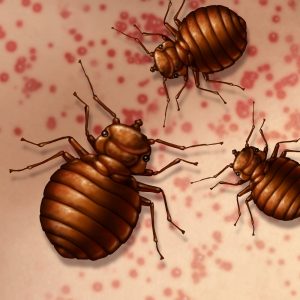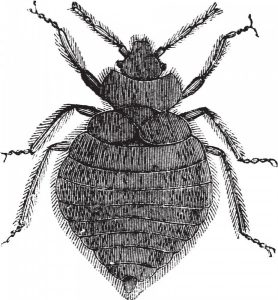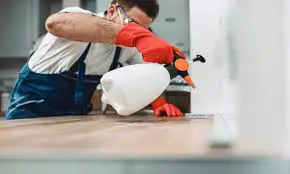Last updated on June 23rd, 2022
Bed bugs are often associated with mattresses, where they live in between the seams or even inside the foam. But that doesn’t mean they won’t manifest in any other furnishing. In fact, besides mattresses, you will commonly find these tiny grisly bloodsuckers in wood furniture. Any wooden piece with cracks or crevices can potentially become a habitation and breeding ground for bed bugs. While eliminating them may seem frustrating, it doesn’t stop one from wondering how to remove bed bugs from wood furniture.You can remove bed bugs from wood furniture by spraying with an insecticide or homemade white distilled vinegar and blasting the furniture with hot steam from a commercial steamer. You can always hire a professional pest control specialist to guide you.
This article will examine each of the methods mentioned above for removing or killing bed bugs in furniture, specifically wood furniture.
Table of Contents
Are bed bugs attracted to wood?
Bed bugs, generally, are not attracted to a particular type of material, and that includes wood. Instead, they favor places that are hidden and safe to lay their eggs and near their food source. To put it more simply, what draws the bug is not the wood or mattress but the favorable living conditions these materials provide. These conditions come in the form of cracks, crevices, and gaps in the wood.
As earlier indicated, the bugs’ preference for these places is because it allows them to be close to the food source, which is primarily human blood. Incidentally, these are places you spend most time resting or relaxing. Thus, you are the one (the host) going to them, which makes it easier for them to infest your home, even without traveling long distances (which they’re not so good at doing).
Signs of bed bugs in wood furniture.
Because bed bugs hide in very tiny spaces, it may be difficult to detect them at first glance. So, how do I know if my wood furniture has bed bugs? Check out for these signs of bed bugs on wood furniture in the section below.
Live Bed Bugs
The most obvious sign that bed bugs has invaded your furniture is when you see them firsthand. Adult bed bugs are usually oval-shaped and reddish-brown colored with six legs. They typically appear rounded if they had a blood meal recently or flat and light if they haven’t sucked blood in a while.

On the other hand, newly hatched bed bugs (also called nymphs) are usually tiny and translucent and thus difficult to notice.
Tiny Eggs
If you inspect dark cracks and crevices in your wooden furniture, you may find milky white bed bug eggs lying inside them. These are unhatched eggs with a size smaller than a grain of rice. To make things easier, you can search with torchlight and magnifying glass.
Blood Spots
Another clear indication of bed bug infestation on your wood piece is when you notice specks of fresh or dried blood on upholstered furniture. This tells you that bed bugs are active in that area and have been feeding. You may also notice the blood spots on your clothes. To be sure, you can carry out a full inspection of the furniture.
Shed Skins
During a lifetime, bed bugs tend to shed their skin no less than five times. The shed skins or exoskeleton looks very similar to the live bug except it’s lighter and motionless. This means they have the same oval shape as bed bugs but are more translucent and pale brown. If you see these anywhere around your furniture, it’s usually an indicator that the pest is lurking.
Droppings
After feeding, bed bugs usually deposit fecal matter. This usually appears as smears or thin black streaks. They may also appear raised or flat.
Pungent Smell
Bed bugs have a very strong, stale smell that is difficult to resist, especially when a piece of wood has been largely infested. It is often described by some as having a “sickly sweet” smell, much like rotting berries. So, even without any of the physical signs above, a bad stink can still give their presence away. Some people may be able to perceive the smell better.
Itchy Swells
Itchy welts on the back of your neck, legs or back can also be a sign of bed bug infestation. This is commonly the case when you have bed bugs on your outdoor couch. Besides the swelling on your skin, you may also notice blood spots on your clothes or upholstery.
Peeled Painting
Besides cracks and crevices, bed bugs can also hide under the paint that has peeled away. So, if your wood piece has old paintings, there’s a big chance you will find bed bugs under the peeled paint.
How to check wood furniture for bed bugs
Even when the signs seem obvious, bed bugs can still be very hard to find, which is understandable considering their small size. However, there are ways to get around this; it only takes a little effort and focus. With this in mind, follow the steps below to check for bed bugs in wood furniture.
Disassemble the Furniture
While this might not always be convenient, disassembling the furniture will enable you to do a more thorough job. This is because bed bugs typically live in the tiniest crevices in wood furniture and may go unnoticed unless you pull the furniture apart.
Once it’s taken apart, you can carefully inspect each piece for bed bugs. Pay close attention to joints, hinges, and the smallest gaps.
This step may be required when picking up used furniture from someone or a second-hand store. If you’re buying a new piece, this is not necessary.
Check the Furniture
For whole wood furniture that cannot be disassembled, you can still inspect them using a flashlight and magnifying glass. For any upholstered chair, dresser drawers, or coffee table you wish to purchase, you can employ a knife or spatula, flashlight and a white sheet to check for the presence of bugs in existing cracks and crevices.
Simply place the white sheet near or under the furniture. Then run the knife along the crevices and joints. You can also use an expired plastic card for this purpose. If bugs are hiding in the wood, there is a chance some will drop on the paper. Next, you can examine the holes and cracks with the flashlight.
You can also check for bed bugs on the couch by inspecting the space between the cushions and down the back of the couch. Inspect each cushion and bag anyone you notice with bug activities. Don’t forget to also check the undersides of your wood tables and headboards.
Once you notice bug infestation anywhere, don’t delay in treating it. We have a separate section dedicated to showing you how to treat furniture for bed bugs.
Why get rid of bed bugs in wooden furniture
If you’ve ever had to deal with bed bug infestation, then you should know how disruptive they can be to life, especially if your previous efforts to get rid of them have proven abortive. Below is a more detailed picture of the possible destruction they can cause if not properly identified and dealt with.
An Invasion of Your Home and Continued Discomfort
The number one reason why bed bugs should never be condoned in a place is that they are invasive. They can quickly transform the sacredness of your home, turning it into an uncomfortable haven. The same furniture you use to relax and unwind can become dreaded because of much biting and sucking from bed bugs. And even if you manage to fall asleep on them, the “snacking” made from your blood may leave the area inflamed and itchy. This makes it more difficult to ease your nerve whenever you want to.
Can Cause Sleeplessness and Affect Your Psychological Health
When you’re conscious of bed bugs, you may develop an acute case of paranoia and experience difficulty in sleeping. When you combine all the sleepless nights with the constant irritation and discomfort, it can quickly take a toll on your psychological health and affect your overall quality of life. However, the real battle begins when you eventually try to expel them. You have to deal with both the mental and financial demands.
Can Pose Some Health Problems
We’ve only talked about the physical discomfort and psychological effects of having bed bugs lurking around your furniture. What about the health implications?
While bed bug bite is painless, they can still cause many health problems.
Some of these include itching, insomnia, allergies, secondary infections, red spots and blisters, Chagas disease, and anaphylactic shock. Kids, seniors, and bedridden patients are usually the ones who suffer the most.
How to remove bed bugs from wood furniture
Recent studies show that bed bug population can double in size in less than two weeks. This means that your whole home can become infested if you delay getting rid of them once detected. Below are the most effective methods to remove bed bugs from wood furniture and other objects in your home.

How to get rid of bed bugs in wood furniture with high heat
A great way to remove bed bugs is to expose them to high temperatures using a steam cleaner. The machine allows you to direct steam from hot water unto every corner, crevices, gap and crack in the wood furniture, which results in the scalding of the bugs and the eggs.
It is highly recommended to use a commercial-grade steam cleaner that can reach temperatures up to 160 degrees Fahrenheit, which is required to annihilate the bugs. Carpet or handheld steam cleaners typically don’t produce that much heat, which makes them less effective for the job.
Steam cleaning can be expensive, but it is the most reliable way of removing bed bugs from wooden objects. Also, due to the excess heat and moisture that comes out from these machines, you need to be careful while using them, as it can cause your furniture to bend or warp.
Make sure you follow the instructions for whatever steam cleaner you choose to use.
Removing Bed Bugs Using Insecticides
Most people prefer using insecticides to kill bed bugs and other insects. And that is mainly because they are very fast and effective. They often kill the bed bugs immediately upon contact.
There are three main categories of insecticides – chemical-based insecticides, oil-based insecticides, and desiccants.
Chemical Based Insecticides
This type of insecticide is fatal and kills insects on contact almost instantaneously. The ones specifically used for bed bugs are usually pyrethroid-based and are available in liquid form, which is usually applied via a spray bottle.
Unfortunately, recent reports show that many bed bugs have developed a genetic resistance to pyrethroid insecticides due to their wide use. So, they may not always work, but it’s still worth considering.
Oil Based Insecticides
While chemical-based insecticides can be very effective, they are not the safest solution. If you want something safer to use, especially around kids and pets, consider using any oil-based insecticides. It’s a more “natural” solution though it hasn’t proven to be very effective.
One of the major challenges with using insecticides for bed bugs is that it can be difficult to apply into tiny gaps and crevices where the bugs live. One way to get around this is to saturate the entire wood piece with the pesticide so none of the bugs will escape. This is important because missing even one bed bug can cause the infestation to return.
As earlier indicated, most insecticides come in a spray form. There are also some that come as a fogger. Whichever one you’re using, make sure you follow the instructions on how best to use it. Wear a respirator mask and gloves, and ensure there’s enough ventilation in the area. If you’re using a fogger inside the house, make sure everyone is outside before activating it. Again, follow the directions provided.
Desiccants
If you prefer a natural alternative to regular pesticides, then consider using Desiccants, such as diatomaceous earth, or DE for short. It’s basically an insecticide powder that you can spray on insects. It works by drying out the insects, so they die from dehydration. Though this method is slow, it works nonetheless.
The good thing about DE is that bed bugs won’t develop resistance to it. On the other hand, since it comes in powder form, it can be difficult to apply effectively into cracks and crevices and other bed bug hiding place. Again, you will need to apply much of it so it can reach the bugs.
To apply the powder, follow the specific instructions on the product. That said, the general procedure is to sprinkle a fine layer of the powder in the area where the bugs reside or travel. Leave it for as long as possible, then suck up the dust with a vacuum cleaner.
How to remove bed bug stain from wood with natural ingredients
Instead of purchasing a commercial bug spray or using heat treatment, you can prepare your own homemade treatment with a natural ingredient like white vinegar and apply it as a spray or wipe-on.
Vinegar is a strong acid that can kill bed bugs when applied directly on them. It’s much safer to use and effective, especially when applied early during an infestation. You may need to apply it for several weeks to depopulate the bugs.
- Pour some vinegar into a spray bottle. Fill it halfway and close tightly.
- Spray some on the part of the furniture that is infested with bugs.
- Make sure to soak the area.
- Repeat for as many crevices and cracks you can find.
- Allow the furniture to dry completely before using it again.
Besides vinegar, there are other natural home remedies you can try out. These are mainly scents that irritate bed bugs. Some of these include ginger, cayenne pepper, and baking soda.
Throw the Furniture Away
Sometimes, treating an infested bed bug furniture is simply not worth it. This is commonly the case if the wood piece is large and full of cracks and crevices or an upholstered furnishing such as a couch or padded chair. Here, a steamer might not be able to completely clear out all the bugs from the tiny holes and grooves. As such, it’s much safer to toss the infested furniture. Attempting to treat it may cause some bugs to escape and infest nearby items.
Get a Professional
Finally, if you have tried all the DIY methods and still have bed bugs lurking around, or if you don’t want to dispose of the furniture, the next best thing you could do is to hire a professional bed bug exterminator.
The professionals will inspect your furniture and determine the best way to remove the bed bugs. While they may cost more money, they will help you eradicate the bugs once and for all.
How to prevent bed bugs in wood furniture
Caulking is a great way to prevent or stop bed bugs from spreading. It has long been used to ward off insects from gaining access into homes. So, what is it exactly?
A caulk is simply a filler or sealant used to fill up tiny spaces or gaps that can potentially become a hiding spot for insects. You can caulk all possible entry points on your wood furniture. This includes crevices, holes, cracks, and gaps. By doing this, you will also be preventing the bugs already in the places from exiting, thereby killing them over time.
That said, caulking on its own will not solve the whole bed bug problem. Some bugs might still be able to get away. If you’re sure an area has been infested, it is better to treat it first and then seal (caulk) it to prevent the bugs from coming back.
With that said, the best way to prevent bugs is to inspect every piece of furniture coming into your home.
FAQs – How to remove bed bugs from wood furniture
How long can bed bugs live in wood furniture?
A bed bug has an average lifespan of 4-6 months and is not influenced by the type of surface or material it leaves in. So, you can expect it to live that long in wood furniture. However, changes in heat or treating the furniture will reduce their lifespan.
Can bed bugs live on wood furniture?
Yes. Bed bugs generally don’t prefer a particular material or surface; they will only live in a place that allows them to hide. Fortunately, some wood furniture has many cracks and gaps, which provides everything bugs need to survive and stay close to the host. So, yes, bugs can live on wood furniture.
Can bed bugs live in leather furniture?
Yes, bed bugs can live in leather furniture or couches. As earlier indicated, they do not have a specific place, material, or surface. They can live in any type of furniture, irrespective of the material, as long as they can find where to hide.
Incidentally, leather furniture has a lot of hiding spots, so it’s not difficult for bed bugs to settle there. In most cases, you will find them sneaking between the cushions and down the back of the couch.
Will painting furniture kill bed bugs?
No, painting will not kill bed bugs. While it can be used to give your furniture a facelift, it is not an effective way of controlling bugs. However, bugs are irritated by the smell of paint fumes. So, painting any piece of furniture can temporarily disperse the bugs; but you can expect them to return once the place is dry and safe.
Do bedbugs lay eggs on wood furniture?
Yes, bed bugs can lay eggs on wood furniture. They typically lay their eggs in tight, dark areas, which can be gaps within wooden structures. So, you will commonly find their eggs in holes, cracks, and crevices in wood furniture or boards. An adult female bed bug can lay between 1-5 eggs per day and up to 250 eggs or more in her lifetime.
What type of vinegar kills bed bugs on wood furniture?
The most effective type of vinegar is the Commercial White Distilled Vinegar. It is highly acidic and will kill the bugs instantly upon contact by disrupting their nervous system, making them to dry out. To make it effective, saturate the infested areas with the solution and spray directly on the spotted bed bugs.

